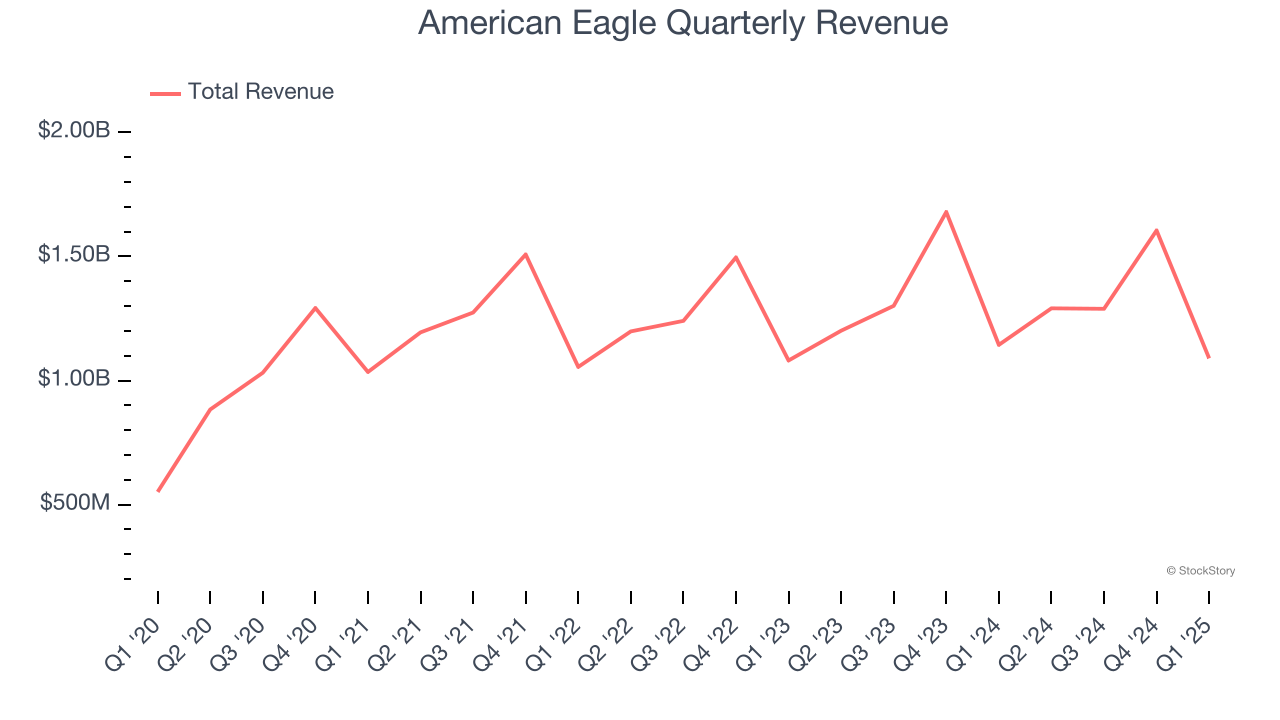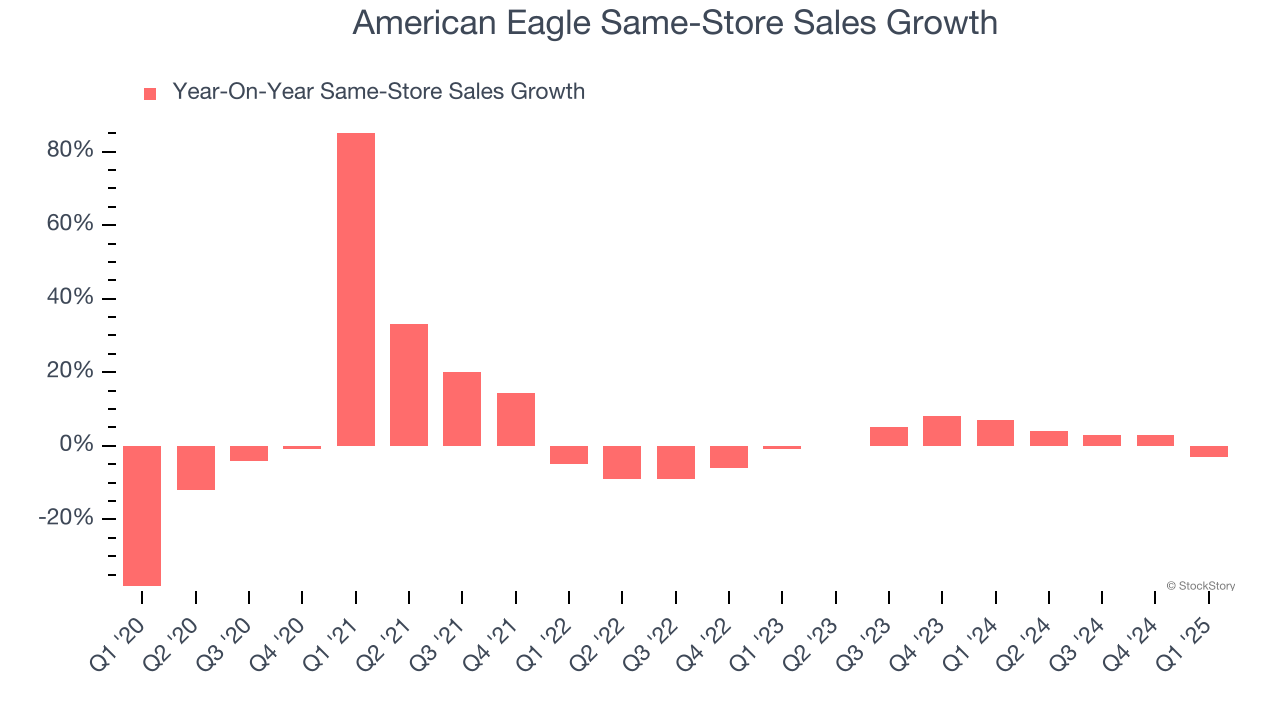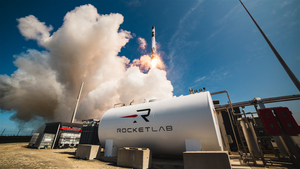
Young adult apparel retailer American Eagle Outfitters (NYSE: AEO) met Wall Street’s revenue expectations in Q1 CY2025, but sales fell by 4.7% year on year to $1.09 billion. On the other hand, next quarter’s revenue guidance of $1.23 billion was less impressive, coming in 0.8% below analysts’ estimates. Its non-GAAP loss of $0.29 per share was 32.6% below analysts’ consensus estimates.
Is now the time to buy American Eagle? Find out by accessing our full research report, it’s free.
American Eagle (AEO) Q1 CY2025 Highlights:
- Revenue: $1.09 billion vs analyst estimates of $1.09 billion (4.7% year-on-year decline, in line)
- Adjusted EPS: -$0.29 vs analyst expectations of -$0.22 (32.6% miss)
- Revenue Guidance for Q2 CY2025 is $1.23 billion at the midpoint, below analyst estimates of $1.24 billion
- Operating Margin: -7.8%, down from 6.8% in the same quarter last year
- Locations: 1,176 at quarter end, up from 1,173 in the same quarter last year
- Same-Store Sales fell 3% year on year (7% in the same quarter last year)
- Market Capitalization: $1.91 billion
“As we noted in our preliminary release, the first quarter was a challenging period for our business. While we are disappointed with the results, we are taking actions to better position the company and drive stronger performance in the upcoming quarters. Our brands remain resilient. The team is executing with urgency as we look to strengthen both the topline and profit flow-through,” commented Jay Schottenstein, AEO’s Executive Chairman of the Board and Chief Executive Officer.
Company Overview
With a heavy focus on denim, American Eagle Outfitters (NYSE: AEO) is a specialty retailer offering an assortment of apparel and accessories to young adults.
Sales Growth
A company’s long-term sales performance can indicate its overall quality. Any business can put up a good quarter or two, but many enduring ones grow for years.
With $5.27 billion in revenue over the past 12 months, American Eagle is a mid-sized retailer, which sometimes brings disadvantages compared to larger competitors benefiting from better economies of scale.
As you can see below, American Eagle’s sales grew at a sluggish 4.3% compounded annual growth rate over the last six years (we compare to 2019 to normalize for COVID-19 impacts) as its store footprint remained unchanged.

This quarter, American Eagle reported a rather uninspiring 4.7% year-on-year revenue decline to $1.09 billion of revenue, in line with Wall Street’s estimates. Company management is currently guiding for a 5% year-on-year decline in sales next quarter.
Looking further ahead, sell-side analysts expect revenue to decline by 1.1% over the next 12 months, a deceleration versus the last six years. This projection doesn't excite us and suggests its products will face some demand challenges.
Today’s young investors won’t have read the timeless lessons in Gorilla Game: Picking Winners In High Technology because it was written more than 20 years ago when Microsoft and Apple were first establishing their supremacy. But if we apply the same principles, then enterprise software stocks leveraging their own generative AI capabilities may well be the Gorillas of the future. So, in that spirit, we are excited to present our Special Free Report on a profitable, fast-growing enterprise software stock that is already riding the automation wave and looking to catch the generative AI next.
Store Performance
Number of Stores
A retailer’s store count influences how much it can sell and how quickly revenue can grow.
American Eagle listed 1,176 locations in the latest quarter and has kept its store count flat over the last two years while other consumer retail businesses have opted for growth.
When a retailer keeps its store footprint steady, it usually means demand is stable and it’s focusing on operational efficiency to increase profitability.

Same-Store Sales
The change in a company's store base only tells one side of the story. The other is the performance of its existing locations and e-commerce sales, which informs management teams whether they should expand or downsize their physical footprints. Same-store sales gives us insight into this topic because it measures organic growth for a retailer's e-commerce platform and brick-and-mortar shops that have existed for at least a year.
American Eagle’s demand has been spectacular for a retailer over the last two years. On average, the company has increased its same-store sales by an impressive 3.4% per year. Given its flat store base over the same period, this performance stems from not only increased foot traffic at existing locations but also higher e-commerce sales as demand shifts from in-store to online.

In the latest quarter, American Eagle’s same-store sales fell by 3% year on year. This decline was a reversal from its historical levels.
Key Takeaways from American Eagle’s Q1 Results
We struggled to find many positives in these results. Its EPS missed and its gross margin fell slightly short of Wall Street’s estimates. Overall, this was a softer quarter, and most retailers seem to be feeling some pain from the macro and from tariffs. The stock traded down 7.4% to $10.35 immediately after reporting.
American Eagle underperformed this quarter, but does that create an opportunity to invest right now? If you’re making that decision, you should consider the bigger picture of valuation, business qualities, as well as the latest earnings. We cover that in our actionable full research report which you can read here, it’s free.






